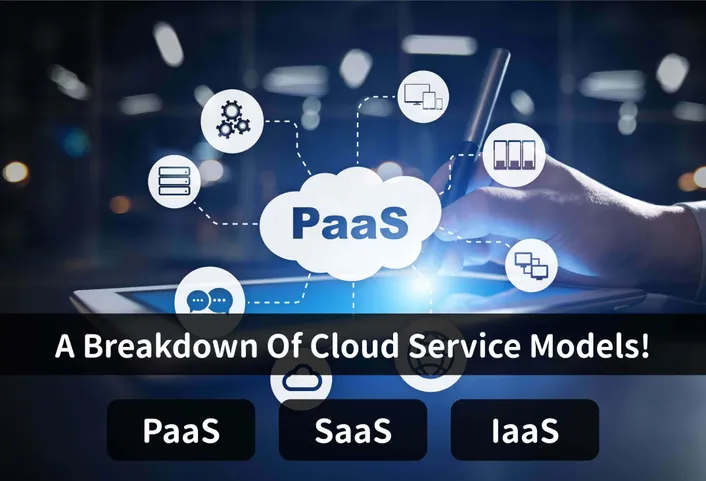What is PaaS? How is it different from SaaS and IaaS? A breakdown of cloud service models!

Understanding the cloud computing service models becomes crucial when businesses no long er manage on-premises IT solutions. In the modern cloud computing landscape, PaaS, SaaS, and IaaS are three important service models, each with unique advantages. This article explores the differences between these models and delves into what PaaS is, helping businesses boost efficiency and cost savings in the rapidly changing tech landscape.
What is PaaS? How does it differ from SaaS and IaaS?
PaaS (Platform as a Service), SaaS (Software as a Service), and IaaS (Infrastructure as a Service) are the three primary service models in cloud computing, and they differ as follows:
PaaS (Platform as a Service)
To gain a deeper understanding of cloud services, it's important to know what PaaS is! PaaS, or Platform as a Service, is a widely used cloud computing service model. It offers a comprehensive platform for application development, testing, deployment, and management. Major PaaS providers like Microsoft Azure App Service, Google App Engine, and Heroku enable developers to swiftly create and manage various applications, from simple websites to complex enterprise-level software. In essence, PaaS streamlines application development and operations, boosting efficiency and reducing management and maintenance overhead.
The most popular PaaS use case in the industry right now is connecting and scaling applications by integrating on-premises and cloud applications. PaaS also supports the development of modern applications, offering developers productivity tools like wikis, bug tracking, source code control, agile development tools, and automated continuous integration (CI) and continuous delivery (CD).
Using PaaS, however, comes with potential challenges. While it offers developers the necessary tools, it also means that switching to another PaaS provider can be complex because applications are built on a specific platform. Maintaining dependence on a specific PaaS provider may be required to avoid extensive modifications during a transition. Additionally, changes in the provider's pricing model can lead to increased operational costs for the applications.
SaaS (Software as a Service)
SaaS (Software as a Service) is a cloud-based software delivery model. Users can access applications via web browsers or mobile apps without the need for local software installation or management. SaaS providers handle software updates, maintenance, and security, alleviating users from software version and maintenance concerns. Popular examples include Google Workspace (formerly G Suite) and Microsoft 365, offering collaborative and productivity tools like Gmail, Google Docs, and Microsoft Word.
IaaS (Infrastructure as a Service)
IaaS (Infrastructure as a Service) offers virtualized infrastructure resources, such as virtual machines, storage, networking, and computing resources. Users can configure and manage these resources to match their needs, similar to traditional hardware management. IaaS provides the flexibility to scale resources up or down as business demands change, making it an efficient way to manage computing and storage resources.
Common IaaS providers include Amazon Web Services (AWS), the world's largest IaaS provider, offering virtual machines, data storage, databases, and computing resources. Another example is the Google Cloud Platform (GCP), which provides IaaS infrastructure services, serverless computing environments, and platform services for managing tools used in Google Search and YouTube server operations.
Comparison of PaaS, SaaS, and IaaS
| PaaS | SaaS | IaaS | |
|---|---|---|---|
| Main Services | App Dev & Ops Platform | Complete Online App Solution | Virtualized Infrastructure Provision |
| Target Audience | Developers, Enterprise IT Departments | Enterprise and Individual Users | System Admins, Enterprise IT |
| Control Permissions | Developers control app development and management | Users use apps without ownership or contro | Users have full control over infrastructure management. |
| Management | Platform providers manage infrastructure | Service providers manage applications | Users are responsible for infrastructure management |
| Deployment | Platform Provider | Software Vendor | Infrastructure Provider |
| Payment Model | Based on the platform and resource usage | Based on the applications used and subscription fees | Based on the resources used and subscription fees |
What are the benefits of enterprises shifting to PaaS? Analyzing three major business advantages!
After grasping the concept of PaaS, we recognize its key cloud computing benefits, including transparent pricing, unified deployment, flexible scalability, disaster recovery capabilities, and an intuitive dashboard, all of which enhance enterprise management. Now, let's explore PaaS's significant business advantages!
Enhancing Innovation Technology for Enterprises
PaaS (Platform as a Service) is vital for boosting enterprise innovation. It offers user-friendly programming components that enable developers to easily incorporate and utilize cutting-edge technologies like chatbots, blockchain, and artificial intelligence (AI).
PaaS excels in AI application development with dedicated tools and resources, including machine learning frameworks, data analysis tools, and AI model training platforms. It simplifies intelligent application creation, speeding up AI technology development and adoption. PaaS also provides application development toolkits for swift innovation using pre-built solutions, eliminating the need for in-house development and maintenance.
Standardized IT Operations
Besides developer support, PaaS offers various features and services for general users, analysts, and professional IT administrators. These contribute to standardized deployment and IT operations, enhancing provisioning speed, automation, scalability, and reducing routine tasks, ultimately improving efficiency and effectiveness for all roles!
For general users
PaaS offers content management tools and services for easy organization and collaboration on digital content like documents, images, and multimedia. These tools often include version control, sharing, and collaboration features, promoting user cooperation and content management.
For analysts
PaaS empowers analysts with robust data analysis capabilities, handling large datasets for valuable insights. It includes ETL, interactive charts, and dashboards for deeper business understanding. Automation tools simplify workflows, enabling analysts to automate data updates and report generation, saving time on analysis.
For professional IT administrators
Professional IT administrators use PaaS performance monitoring tools for real-time application and infrastructure tracking, including automation, log management, performance monitoring, and error tracking. PaaS also offers cloud security features like authentication, data encryption, vulnerability scanning, and security monitoring, ensuring smooth operations and data security.
Reducing Security Risks
Most IT decisions revolve around three core principles: innovation, efficiency, and risk reduction. For large enterprises, mitigating security risks is a top priority. PaaS offers a robust security framework, including vulnerability scanning, security monitoring, automated backups, disaster recovery, and regulatory compliance support. PaaS platforms typically adhere to various compliance standards like GDPR and HIPAA, ensuring legal compliance with data protection and privacy regulations for businesses.
Examples of PaaS Applications – Suitable for Every Industry!
What is PaaS? It has a wide range of use cases across various industries and business domains. Here are common use cases for PaaS, and actual applications may vary based on enterprise needs and industry-specific requirements. Let's explore how PaaS can be applied to your business!
E-commerce platform
PaaS offers tools for e-commerce businesses to develop and customize online stores effortlessly. Developers use PaaS-provided components to create features meeting specific needs. For high-traffic periods, PaaS automates scaling, ensuring seamless expansion without infrastructure concerns.
Traditional enterprises transitioning to the cloud
PaaS can help traditional enterprises achieve cloud transformation, improving efficiency and flexibility while reducing infrastructure management costs and complexity. However, a successful transition requires careful planning. Businesses must assess their needs, choose suitable applications or workloads for migration (e.g., internal apps, CRM, databases), and select a reliable PaaS provider based on specific requirements, considering different toolsets, services, and pricing.
Startup Technology Company
PaaS offers startups a flexible and efficient platform for development and operations, expediting product launches, cutting costs, and facilitating rapid application scaling. Startups can utilize PaaS's swift deployment features to bring their products to market, making it ideal for fast-paced and competitive environments.
Top Cloud Hosting Services - Chiheng
After reading this full introduction to what PaaS is, we now know it's a cloud service based on cloud hosting. Choosing the right "cloud hosting provider" is a crucial part of realizing the benefits of PaaS, as it directly impacts its performance, reliability, and security. Infinite International offers Microud cloud hosting with unlimited bandwidth, matching the specifications of major brands, and providing diverse solutions. Whether you're a novice or a pro, we have you covered for all your business needs. If you require cloud hosting, don't hesitate tocontact us!






